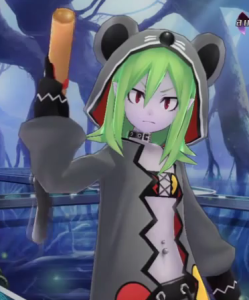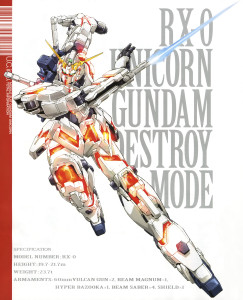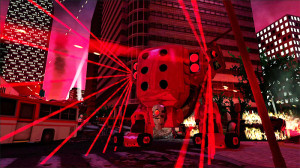Protuding Proboscis Peril – The Kikai Empire Attacks!
by RadiumEyes, HSM guest contributor
A most peculiar visitor preceded the attack. Without any explanation regarding its origin or intentions, an extraterrestrial craft anchored itself downtown; this oddly-shaped vessel, adorned with a long-nosed face, hovered curiously over the skyline, greeting onlookers with silence. Those who gathered to view the bizarre ship didn’t know what to make of it; its very presence seem too defy anyone to understand.
Before long, however, the vehicle’s inhabitants spoke – they want Earth’s unconditional surrender. As thirty minutes passed, GNN reported on the alien visitors, and Earth’s governments failed to capitulate. With no reply, the aliens retaliated with force – downtown became a warzone as mechanized soldiers descended upon the streets. Panic quickly set in; people quickly abandoned the scene as the first wave of attackers decimated the area. However, a lone voice rose over the chaos, imploring everyone to oppose this menace.
Thus begins the defense of Earth against the Kikai Empire, humanity against invaders from beyond the solar system. Granzella’s new community event (which utilizes the fighting system previously seen in Great Edo) debuted in Japan some months ago, but the NA server now has the opportunity to experience this limited-engagement game that makes galactic heroes of those who participate. Players rely on their own strength and fortitude in order to vanquish an alien threat, defeating the Empire’s minions and sabotaging their advanced machinery to repel an attack force intent on beating the planet into submission. The odds, as one may guess, can be staggering – you fight as a single hero as you pursue your objectives through the streets of Tokyo.
 You are not alone, however – a secret military installation in the Secret Island Hideaway (tucked behind a large rock glyph) serves as a base of operations, and it provides you with a basic weapon and some armor to prepare you for the fight. Humanity’s defense against the Kikai Empire harkens back to classic tokusatsu and henshin conventions – the plot (a massive, technologically-advance spacefaring force attacking a planet that taps into a heroic group that possesses high technology of their own) remains a staple in anime.
You are not alone, however – a secret military installation in the Secret Island Hideaway (tucked behind a large rock glyph) serves as a base of operations, and it provides you with a basic weapon and some armor to prepare you for the fight. Humanity’s defense against the Kikai Empire harkens back to classic tokusatsu and henshin conventions – the plot (a massive, technologically-advance spacefaring force attacking a planet that taps into a heroic group that possesses high technology of their own) remains a staple in anime.
Fans of such shows as Gatchaman and Voltron (the latter an American amalgamation of two separate series) can instantly recognize the formula. Gatchaman, in particular, is a great illustrative example. Henshin programs feature heroic protagonists who go through a transformation process to don their gallant defender personas – hence the term henshin, which translates into “transformation.”
With the game itself, players navigate the city of Tokyo’s metropolitan center to find and destroy the Kikai Empire’s underlings; you can choose from one of three professions, each commanding their own powers. The Beam Samurai class offers a front-line melee fighting style, utilizing shoulder-mounted beam sabers (echoing similar weapons such as the Gundam beam sabers and other energy weaponry), making for an excellent close-combat warrior. If you wish to go with subterfuge and sabotage, the Honeycomb Hacker gives you that opportunity; Hackers can alter a Kikai robot’s programming, making it attack its own allies – a sort of hacking aikido, where you use your opponent’s own powers against it. Finally, there is the Battle Healer, who can keep allies’ fitness up by restoring their health; the Battle Healer employs special steel gloves in combat, allowing him (or her) to stay active in combat while simultaneously tending to a team’s well-being.
As Jin Lovelace mentioned, however, the Battle Healer profession suffers greatly combat-wise – it’s best suited for a supportive role, and tackling the Empire alone as a Battle Healer can be more challenging than perhaps should be expected. Healers shouldn’t have their attack powers so compromised as to be practically useless when engaging in combat by themselves; when one gives players the option of single-player battle, this discrepancy among the classes becomes all the more pronounced.
Having a well-rounded team composed of one player from each profession would make the game very fruitful – playing together for a common goal (and a common good) emphasizes team effort, where everyone works together for a shared objective and can coordinate their tactics to best suit discrete situations. Disregarding their status as NPCs for the moment, it’s best to visualize the Kikai Empire as a company of sapient AI that can be defeated with a methodical approach – they’re powerful, but not so strong as to be overwhelming, and each unit has a set movement pattern that can be exploited.
Of course, this betrays the fact that the Kikai soldiers are merely code – if they operated as (and actually were) real-life entities, they could quite easily decimate the Earth within a few days. The War of the Worlds ending, where the Martian invaders succumb to diseases they had no exposure to before, may be rendered irrelevant if the Kikai Empire didn’t act so predictably.
But this game recognizes itself in a very meta way – the final boss, the Emperor himself, knows that he’s merely a pre-programmed end battle that would define the outcome of the fight, and he bemoans his inability to break free from the confines of video game precepts. However, the actual last battle (after you defeat him in his throne room) gives you an option – the player chooses how this ultimate showdown will play out, as the Emperor doesn’t want to give up easily. Such a delightfully comic way of settling this conflict shows Granzella’s well aware of conventions, and made the Emperor aware of it himself.
The Emperor is comparable to Linda from Hyperdimension Neptunia – in Neputunia, Linda received the nickname “Underling” from the protagonists, a nod to standard tropes in Japanese RPGs where the underling is powerful, yet answers to a stronger authority. Linda’s exasperation over not being treated with respect (she resents being categorized as a “mid-boss” or mere thug, which implies she’s being pushed around by a superior who wants her to do the dirty work) works wonderfully in Neptunia, and the Kikai Emperor feels the same ennui and resentment – he can’t escape his destiny as the commander of an extraterrestrial force, which naturally makes him the highest-ranking officer and the major target for Earth’s forces. Any influence over a battle’s development would thus make him feel more comfortable – at least he can get a sense of sway on what happens around him.
As far as the stages are concerned, Granzella provided numerous small combat areas, all centered around metropolitan Tokyo. Shinjuku takes prominence here – this would make perfect sense in the context of the story, as Shinjuku is Tokyo’s administrative center and contains numerous government and business buildings. Confrontations with the enemy take you across Shinjuku; you must locate the UFO hovering over Tokyo and enter it surreptitiously, while fighting through numerous opponents.
While players traverse the city, they come across various quests that offer rewards for completion. These range from saving citizens trapped in battle zones to reuniting lovers; this keeps you on your toes, as you now have to help defenseless people evacuate the city while you tackle the primary assignments. Assisting these residents brings some immediacy to the battle – you’re waging a war that puts many lives in danger, and you must make sure people can safely escape. War affects those around you, not only yourself; the world depends on every hero to resist the invaders and bring peace back to a devastated community.
Now, I haven’t mentioned other aspects of the event, such as the companions who can support you in combat. These “partners” (three in all – dog, rabbit and talking daikon) assist players in different ways, requiring a bit of tactical planning to utilize them effectively. For example, the rabbit Partner is a
“recovery-type,” healing the hero at regular intervals; knowing the rate of these intervals would seriously help players, as one can retreat to a safe distance to allow the rabbit to mend one’s accumulated wounds before continuing. If you decide not to purchase a Partner, however, you could still plan accordingly – establishing a team and working in concert will greatly benefit everyone involved. With friends around to assist and coordinate strikes, success can be assured if the team is a unified lot, taking down the baddies with skill and precision.
The game is surprisingly fun and comprehensive; the fighting system is the same one seen in the Great Edo space, but the Kikai Empire event offers some more diversity than simply “kill yokai, rinse, repeat.”
Instead of simply attacking enemies left and right, you have a story tying everything together – you’re up against a powerful adversary with conquest in mind, and defeating this menace necessitates finding the mastermind and taking him out. It may be a simple premise, but the story offers an effective narrative for your plight – the Earth’s survival is at stake, and one should tread carefully while confronting these aggressors. To make matters a bit more complicated, civilians are trapped in the city, waiting to be rescued; they don’t have the luxury of advanced military equipment to defend themselves, and thus rely on you to assure their security.
In Great Edo, players embarked alone or in a team against legendary creatures, but they did so outside the city limits; here, the attackers bring the struggle to Tokyo itself, in a concerted effort to not only surmount Earth’s defenses, but also show the planet they mean business. Nothing quite conveys that sentiment like attacking a major city, and the aliens want nothing less than complete planetary domination.
As can be expected, preparation is paramount, and this game does an admirable job of letting players customize their experience. You have various weapons, Partners and professions at your disposal, allowing some good (if still limited) customization. One’s experience isn’t limited to one class, and approaching the game from a different angle (i.e., a different combination of skills) shows the depth of the system. It may not be as complex an arrangement as, say, titles like Disgaea or Dungeons and Dragons, but Granzella’s latest effort offers a splendid diversion overall.
Having said that, occasional snags did appear during the event. When time finally came for the game to commence, the ensuing flood of users briefly caused the server to experience some lag; it looked like too many people tried to enter the instance all at once, and the opening cinematic didn’t load for several. This opening scrawl, meant to introduce players to the story, took a while to appear within the first hour or so of access, leaving people high and dry for a while. Eventually, this got all sorted out after people returned to it later, but it felt like the server didn’t anticipate such a large (and immediate) influx from the beginning. Thankfully, this didn’t appear to cause issues outside of a hiccup in the cinematic, but the fact remains that the sudden flow of users to the game prompt triggered a brief setback.
Also, the discrepancy between classes can make for a frustrating experience; it becomes a chore when you cannot deal that much damage, and your healing capability (apparently) leaves a bit to be desired. This can feasibly be counterbalanced by consumable items that can increase the Battle Healer’s skills – the game does offer a power boost (in the form of a can of soda), but that’s strength alone. Organizing a team to tackle the Empire shouldn’t be a necessity when you opt for one class, especially when that class feels substantially weaker than the other two. Balancing them a little more efficiently would be excellent – give the Battle Healer a bit more of a combative edge, so that a player with that profession doesn’t feel like facing a steep uphill battle.

Perhaps including an introductory movie would’ve been best handled by allowing users to view it at their leisure, instead of making it mandatory. Let people watch it from a screen, instead of prefacing entry into the secret base with it – that way, players can catch up on the narrative without having to see it (from beginning to end) before even getting inside to play. Happily, the movie only plays once, so players do not have to sit through it every time they enter the headquarters. It’s a single-time thing, and it serves its purpose well enough; you understand the operation’s importance, and can freely enter and exit the space after that.
Aside from that, the game does suffer from some slight lag, but that can be expected from a space with such high traffic. Lag isn’t significant enough to adversely affect one’s gameplay, fortunately – once you begin a mission, it plays rather smoothly, without any interruptions to speak of. Any large undertaking like this would generate lag initially, and this is no different; luckily, it doesn’t seem to have any major hang-ups in this regard. It plays well, even with the occasional slowdown; the various mission spaces don’t tax one’s connection (at least, not from what I’ve noticed), and each individual stage feels seamless.
All in all, Granzella’s sci-fi outing is a blast, and although it does have its share of slowness, the invasion event became a good slog through Tokyo repelling those mechanical opponents standing between you and victory. The Emperor’s meta-dialogue at the boss fight showed how amusing the character is; he has his own little quirks, and his desire to succeed against humanity results in a rather cute exchange. Moments like this make playing something all the more enjoyable, as the developers knew how to make the game light-hearted.
Share
| Tweet |



 Twitter
Twitter
I thoroughly enjoy this article, Radium. You’ve really hit it on the mark in regards to the fun factor this game presents. And seeing as how I’m a huge fan of the Tekkeman Blade series and a slight Gundam head, this really took me back in the days of Robotech and evil Federations, invasions and what not. Heck, it even has a bit of Xenogears zing to it.
Cheers buddy! 8D
Nice article. Very good I must say. You might just had sold me the game.
That picture with the 5 windged cape teen… Don’t remember how it was called in french. But it brang back memories. Used to loved that show. I’ll buy one of these outfit. Especially the “owl” the chubby guy who usually stood in the aircraft, away from battle ground
Protruding Proboscis Peril…LOL
I found the proboscis protruding from the Emperor’s cod piece to be quite perilous. Especially when that electroplasmic, magenta goo comes spewing from it. Or when he props himself upon the appendage immediately following his defeat. Yikes.